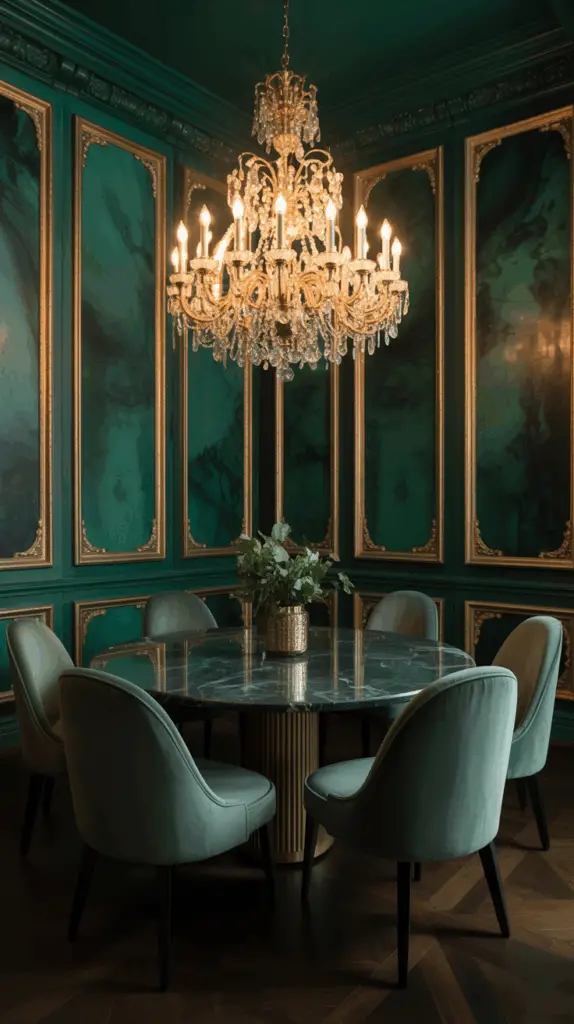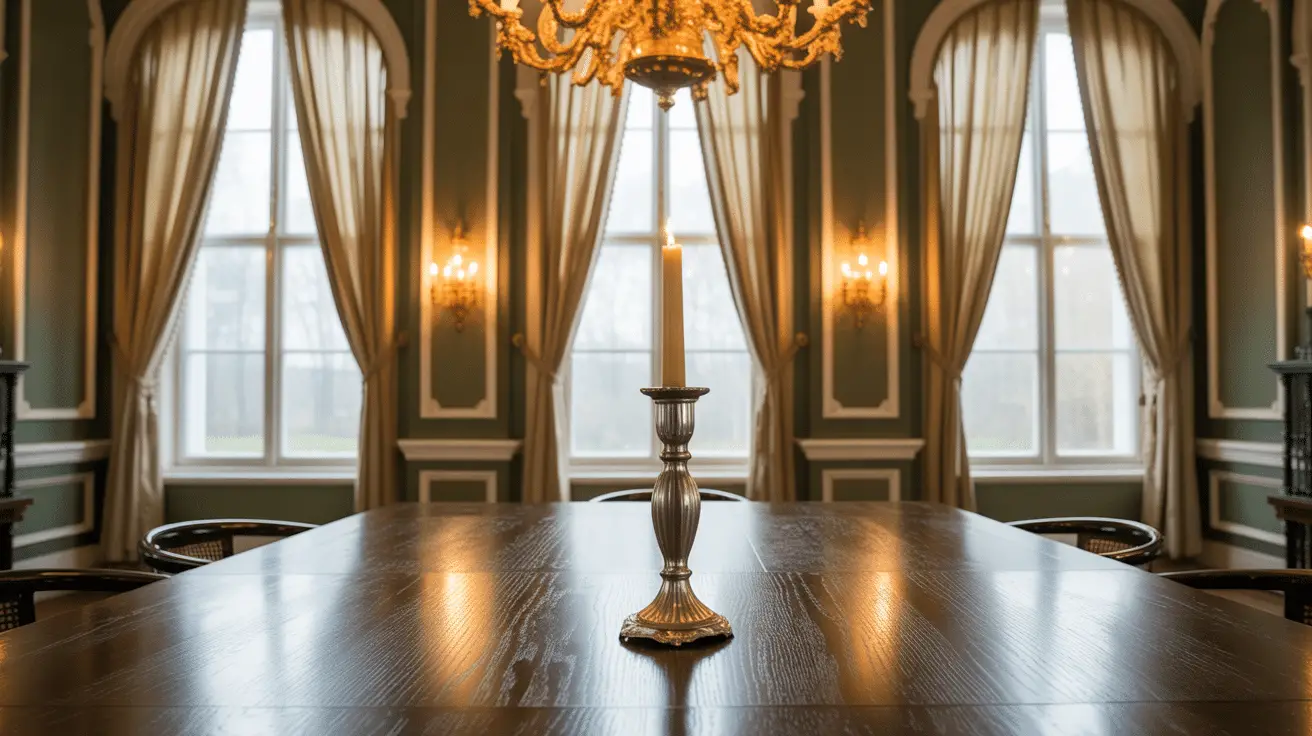How to Style a Green Dining Room with Elegance and Sophisticated Flair
Table of Contents
Introduction:
Green is more than just a color—it’s a design philosophy rooted in harmony, sophistication, and nature. In recent years, green has surged in popularity in home decor, especially in dining rooms, where it creates a sense of calm, connection, and understated luxury. Whether you lean toward sage, emerald, olive, or forest green, this hue is an incredibly versatile canvas for styling a dining space with both elegance and flair.
A well-styled green dining room can be cozy or dramatic, traditional or modern. The richness of the color lends itself to layered textures, bold contrasts, and even opulent metallic accents. With the right combination of paint, furniture, lighting, and accessories, your dining area becomes not just a place for meals—but a visual experience.
In this guide, you’ll learn how to style a green dining room thoughtfully and beautifully. From choosing the perfect shade and balancing color pairings to selecting complementary furniture and styling techniques, we’ll explore practical yet stylish ideas to help you craft a room that’s inviting, polished, and perfectly on trend.
Choosing the Right Shade of Green for Your Dining Room
The key to styling a green dining room with elegance begins with selecting the right shade. Not all greens are created equal—each carries a distinct mood and design potential. Lighter greens like sage and mint offer a soft, fresh feel, while deeper tones such as emerald, olive, and forest green evoke richness, coziness, and a sense of drama.
The shade you choose should reflect your dining room’s natural light, size, and existing architectural features. A north-facing room with limited sunlight might benefit from warmer, olive-based greens, while a sunlit space can carry deeper or cooler hues without feeling heavy.
Pairing green with the right complementary colors can amplify the room’s elegance. Green pairs beautifully with neutral tones like ivory, beige, taupe, and black. Metallic accents—particularly gold or antique brass—help add luxury and depth.
Visual Guide: Popular Green Shades and Their Design Vibes
| Shade of Green | Design Mood | Best Room Features |
| Sage Green | Calm, airy, Scandinavian | Light wood floors, white trim |
| Emerald Green | Glamorous, rich, timeless | High ceilings, bold lighting |
| Olive Green | Earthy, warm, cozy | Natural textures, vintage decor |
| Forest Green | Dramatic, elegant, grounded | Dark furniture, large windows |
| Mint Green | Playful, fresh, modern | Light floors, minimalist furniture |
Pairing Green with Complementary Colors and Textures
A green dining room becomes truly elegant when it’s complemented by the right color and texture palette. While green is inherently a grounding and calming color, it thrives when balanced with warmth, contrast, and thoughtful material choices.
To elevate the look, combine green with neutral shades such as warm white, cream, charcoal, and natural wood tones. For more contrast and glamour, introduce black accents or brushed metals. Textural layering—like velvet seat cushions, linen drapes, rattan details, or glossy ceramics—helps prevent the space from feeling flat or too monochromatic.
Color pairing should consider mood and balance. For example, pairing olive green with tan leather and walnut wood creates a relaxed, organic vibe. Meanwhile, emerald green and gold evoke luxury and formality. Layering visual warmth through texture is equally important: a soft wool rug underfoot, velvet-upholstered dining chairs, or a linen runner on the table all help add dimension.
Elegant Pairing Ideas: Complementary Colors and Textures
| Green Shade | Ideal Pairings | Textural Suggestions |
| Sage Green | Ivory, oak, pale gray | Linen, unfinished wood, ceramics |
| Emerald Green | Brass, navy, marble | Velvet, lacquered wood, glass |
| Olive Green | Beige, chocolate brown, matte black | Woven fabrics, leather, rattan |
| Forest Green | Cream, bronze, charcoal | Heavy drapes, natural wool, metal |

Incorporating Stylish Furniture That Enhances Green Walls
Furniture in a green dining room plays a critical role in bringing balance, structure, and character to the space. It should not only harmonize with the color palette but also enhance the room’s personality.
Start with the dining table—opt for dark wood, black-stained oak, or even a marble-top table for an upscale finish. Tables with organic shapes or traditional silhouettes in vintage-inspired finishes pair especially well with green tones. When it comes to dining chairs, upholstered styles in velvet, leather, or natural linens add texture and softness.
Sideboards or buffets in complementary tones—such as walnut, cream, or matte black—can offer practical storage while grounding the overall layout. Don’t overlook the importance of balance: in a room with bold green walls, subtle, well-crafted furniture can offer visual relief and elegance.
Think about leg styles, handle details, and finishes. Brass knobs or black iron accents can mirror other decorative elements in the room and create a sense of cohesion.
Furniture Selection Guide for a Green Dining Room
| Furniture Item | Style Suggestions | Best Pairings with Green Walls |
| Dining Table | Solid wood, marble, rustic-modern | Dark greens + walnut or marble |
| Dining Chairs | Velvet, cane-back, linen-covered | Sage greens + soft neutrals |
| Sideboard | Vintage wood, lacquered, metal legs | Forest green + dark-stained pieces |
| Bar Cart | Brass, glass, or matte black frame | Emerald green + gold accents |
Elevating the Space with Art and Wall Details
Art and wall details are the finishing touches that give a green dining room character and flair. These elements should complement the room’s tone while offering visual contrast or storytelling.
Wall art in neutral tones, black and white photography, or abstract works with touches of gold or rust can help create focal points and break up expanses of green. In more traditional spaces, consider framed botanical prints, vintage oil paintings, or a gallery wall with antique frames to enhance a sense of warmth and collected charm.
Beyond art, architectural details such as wainscoting, picture molding, or paneling painted in the same green hue add subtle elegance. These features offer a layered, designer look without overwhelming the space. If your dining room lacks natural texture, adding wallpaper with a subtle pattern—like grasscloth or damask—can bring dimension and refinement.
Mirrors are another powerful tool, especially in smaller or darker rooms. Choose mirrors with ornate, antique-style frames or sleek modern shapes, depending on your overall aesthetic.
Wall Styling Guide: Art and Architectural Touches
| Detail Type | Design Approach | Impact on Green Dining Room |
| Artwork | Neutral abstract, vintage, or bold | Adds contrast and personalization |
| Molding/Paneling | Painted in same green or off-white | Adds architectural interest |
| Wallpaper | Textured or tonal patterns | Enhances depth and texture |
| Mirrors | Brass or aged wood frames | Reflects light, adds openness |
Lighting Techniques for a Warm and Inviting Atmosphere
Lighting is the anchor that defines ambiance in any room, and in a green dining room, it can either enhance or mute the richness of the palette. Choosing the right lighting scheme helps create warmth, draw attention to key features, and support functionality.
Start with a statement overhead light—such as a brass chandelier, modern orb pendant, or sculptural fixture—to set the tone. Then layer with ambient lighting like wall sconces, buffet lamps, or even under-shelf LED strips to create glow and depth in the evenings.
Choose warm-toned bulbs (2700K–3000K) that cast a soft, flattering light over green hues. These tones bring out the warmth in olive or sage and prevent deeper greens from appearing too cold or sterile.
Candles or lanterns are perfect additions for dinner parties or cozy evenings. Decorative lighting such as backlit art or pendant spotlights can also become unexpected design elements, especially when used to highlight artwork or architectural details.
Lighting Strategy for Elegant Green Dining Rooms
| Lighting Element | Placement | Style Tip |
| Chandelier/Pendant | Centered above dining table | Use brass or glass for warmth |
| Wall Sconces | Flanking art or sideboards | Opt for candle-style or modern metals |
| Table Lamps | On buffets or corners | Choose ceramic or linen shades |
| Accent Lighting | Shelves, artwork, mirrors | Backlight or spotlight select items |
Adding Natural Elements for a Lush, Balanced Look
Natural elements bring life, texture, and contrast to a green dining room. They break up formality and soften strong color palettes, contributing to a more grounded, organic space.
Start with greenery itself—real or faux plants add a natural connection and reinforce the color theme. A large potted plant in a rattan or ceramic pot, a simple vase of eucalyptus, or a sculptural branch arrangement on the table can all introduce movement and freshness.
Woods with visible grain, woven baskets, stoneware, and clay vessels all lend authenticity. Consider a raw-edge wood bowl as a centerpiece or linen napkins in a natural flax color to add rustic elegance.
Even if your green palette leans glamorous or dramatic, the introduction of natural textures ensures the space remains welcoming and not overly formal.
Nature-Inspired Additions: Organic Touches to Try
| Natural Element | Ideal Use | Design Benefit |
| Indoor Plants | Corners, tabletops, sideboards | Adds vibrancy and life |
| Raw Wood Accents | Bowls, furniture, shelves | Introduces warmth and depth |
| Textiles (linen, jute) | Runners, napkins, placemats | Brings texture and softness |
| Stoneware/Ceramics | Vases, dishes, candle holders | Earthy, artistic, grounding |
Conclusion
Styling a green dining room with elegance and flair is a balance of bold color, thoughtful texture, and sophisticated detail. Green is versatile, rich in tone, and emotionally grounding—qualities that make it an ideal backdrop for both everyday dining and special occasions.
By carefully selecting the right shade, incorporating complementary tones, choosing furniture that enhances your design intent, and layering in lighting, art, and natural textures, your green dining room can become the crown jewel of your home. Whether you lean minimalist or maximalist, traditional or modern, the richness of green allows for a world of refined, expressive possibilities.

